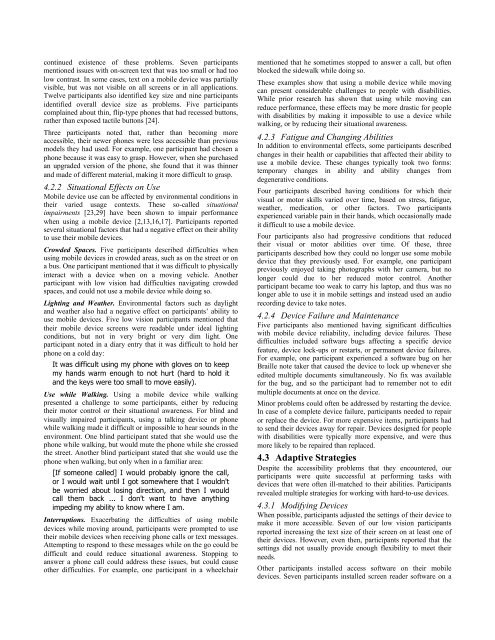Freedom to Roam: A Study of Mobile Device Adoption and - UMBC
Freedom to Roam: A Study of Mobile Device Adoption and - UMBC
Freedom to Roam: A Study of Mobile Device Adoption and - UMBC
Create successful ePaper yourself
Turn your PDF publications into a flip-book with our unique Google optimized e-Paper software.
continued existence <strong>of</strong> these problems. Seven participants<br />
mentioned issues with on-screen text that was <strong>to</strong>o small or had <strong>to</strong>o<br />
low contrast. In some cases, text on a mobile device was partially<br />
visible, but was not visible on all screens or in all applications.<br />
Twelve participants also identified key size <strong>and</strong> nine participants<br />
identified overall device size as problems. Five participants<br />
complained about thin, flip-type phones that had recessed but<strong>to</strong>ns,<br />
rather than exposed tactile but<strong>to</strong>ns [24].<br />
Three participants noted that, rather than becoming more<br />
accessible, their newer phones were less accessible than previous<br />
models they had used. For example, one participant had chosen a<br />
phone because it was easy <strong>to</strong> grasp. However, when she purchased<br />
an upgraded version <strong>of</strong> the phone, she found that it was thinner<br />
<strong>and</strong> made <strong>of</strong> different material, making it more difficult <strong>to</strong> grasp.<br />
4.2.2 Situational Effects on Use<br />
<strong>Mobile</strong> device use can be affected by environmental conditions in<br />
their varied usage contexts. These so-called situational<br />
impairments [23,29] have been shown <strong>to</strong> impair performance<br />
when using a mobile device [2,13,16,17]. Participants reported<br />
several situational fac<strong>to</strong>rs that had a negative effect on their ability<br />
<strong>to</strong> use their mobile devices.<br />
Crowded Spaces. Five participants described difficulties when<br />
using mobile devices in crowded areas, such as on the street or on<br />
a bus. One participant mentioned that it was difficult <strong>to</strong> physically<br />
interact with a device when on a moving vehicle. Another<br />
participant with low vision had difficulties navigating crowded<br />
spaces, <strong>and</strong> could not use a mobile device while doing so.<br />
Lighting <strong>and</strong> Weather. Environmental fac<strong>to</strong>rs such as daylight<br />
<strong>and</strong> weather also had a negative effect on participants’ ability <strong>to</strong><br />
use mobile devices. Five low vision participants mentioned that<br />
their mobile device screens were readable under ideal lighting<br />
conditions, but not in very bright or very dim light. One<br />
participant noted in a diary entry that it was difficult <strong>to</strong> hold her<br />
phone on a cold day:<br />
It was difficult using my phone with gloves on <strong>to</strong> keep<br />
my h<strong>and</strong>s warm enough <strong>to</strong> not hurt (hard <strong>to</strong> hold it<br />
<strong>and</strong> the keys were <strong>to</strong>o small <strong>to</strong> move easily).<br />
Use while Walking. Using a mobile device while walking<br />
presented a challenge <strong>to</strong> some participants, either by reducing<br />
their mo<strong>to</strong>r control or their situational awareness. For blind <strong>and</strong><br />
visually impaired participants, using a talking device or phone<br />
while walking made it difficult or impossible <strong>to</strong> hear sounds in the<br />
environment. One blind participant stated that she would use the<br />
phone while walking, but would mute the phone while she crossed<br />
the street. Another blind participant stated that she would use the<br />
phone when walking, but only when in a familiar area:<br />
[If someone called] I would probably ignore the call,<br />
or I would wait until I got somewhere that I wouldn't<br />
be worried about losing direction, <strong>and</strong> then I would<br />
call them back ... I don't want <strong>to</strong> have anything<br />
impeding my ability <strong>to</strong> know where I am.<br />
Interruptions. Exacerbating the difficulties <strong>of</strong> using mobile<br />
devices while moving around, participants were prompted <strong>to</strong> use<br />
their mobile devices when receiving phone calls or text messages.<br />
Attempting <strong>to</strong> respond <strong>to</strong> these messages while on the go could be<br />
difficult <strong>and</strong> could reduce situational awareness. S<strong>to</strong>pping <strong>to</strong><br />
answer a phone call could address these issues, but could cause<br />
other difficulties. For example, one participant in a wheelchair<br />
mentioned that he sometimes s<strong>to</strong>pped <strong>to</strong> answer a call, but <strong>of</strong>ten<br />
blocked the sidewalk while doing so.<br />
These examples show that using a mobile device while moving<br />
can present considerable challenges <strong>to</strong> people with disabilities.<br />
While prior research has shown that using while moving can<br />
reduce performance, these effects may be more drastic for people<br />
with disabilities by making it impossible <strong>to</strong> use a device while<br />
walking, or by reducing their situational awareness.<br />
4.2.3 Fatigue <strong>and</strong> Changing Abilities<br />
In addition <strong>to</strong> environmental effects, some participants described<br />
changes in their health or capabilities that affected their ability <strong>to</strong><br />
use a mobile device. These changes typically <strong>to</strong>ok two forms:<br />
temporary changes in ability <strong>and</strong> ability changes from<br />
degenerative conditions.<br />
Four participants described having conditions for which their<br />
visual or mo<strong>to</strong>r skills varied over time, based on stress, fatigue,<br />
weather, medication, or other fac<strong>to</strong>rs. Two participants<br />
experienced variable pain in their h<strong>and</strong>s, which occasionally made<br />
it difficult <strong>to</strong> use a mobile device.<br />
Four participants also had progressive conditions that reduced<br />
their visual or mo<strong>to</strong>r abilities over time. Of these, three<br />
participants described how they could no longer use some mobile<br />
device that they previously used. For example, one participant<br />
previously enjoyed taking pho<strong>to</strong>graphs with her camera, but no<br />
longer could due <strong>to</strong> her reduced mo<strong>to</strong>r control. Another<br />
participant became <strong>to</strong>o weak <strong>to</strong> carry his lap<strong>to</strong>p, <strong>and</strong> thus was no<br />
longer able <strong>to</strong> use it in mobile settings <strong>and</strong> instead used an audio<br />
recording device <strong>to</strong> take notes.<br />
4.2.4 <strong>Device</strong> Failure <strong>and</strong> Maintenance<br />
Five participants also mentioned having significant difficulties<br />
with mobile device reliability, including device failures. These<br />
difficulties included s<strong>of</strong>tware bugs affecting a specific device<br />
feature, device lock-ups or restarts, or permanent device failures.<br />
For example, one participant experienced a s<strong>of</strong>tware bug on her<br />
Braille note taker that caused the device <strong>to</strong> lock up whenever she<br />
edited multiple documents simultaneously. No fix was available<br />
for the bug, <strong>and</strong> so the participant had <strong>to</strong> remember not <strong>to</strong> edit<br />
multiple documents at once on the device.<br />
Minor problems could <strong>of</strong>ten be addressed by restarting the device.<br />
In case <strong>of</strong> a complete device failure, participants needed <strong>to</strong> repair<br />
or replace the device. For more expensive items, participants had<br />
<strong>to</strong> send their devices away for repair. <strong>Device</strong>s designed for people<br />
with disabilities were typically more expensive, <strong>and</strong> were thus<br />
more likely <strong>to</strong> be repaired than replaced.<br />
4.3 Adaptive Strategies<br />
Despite the accessibility problems that they encountered, our<br />
participants were quite successful at performing tasks with<br />
devices that were <strong>of</strong>ten ill-matched <strong>to</strong> their abilities. Participants<br />
revealed multiple strategies for working with hard-<strong>to</strong>-use devices.<br />
4.3.1 Modifying <strong>Device</strong>s<br />
When possible, participants adjusted the settings <strong>of</strong> their device <strong>to</strong><br />
make it more accessible. Seven <strong>of</strong> our low vision participants<br />
reported increasing the text size <strong>of</strong> their screen on at least one <strong>of</strong><br />
their devices. However, even then, participants reported that the<br />
settings did not usually provide enough flexibility <strong>to</strong> meet their<br />
needs.<br />
Other participants installed access s<strong>of</strong>tware on their mobile<br />
devices. Seven participants installed screen reader s<strong>of</strong>tware on a











